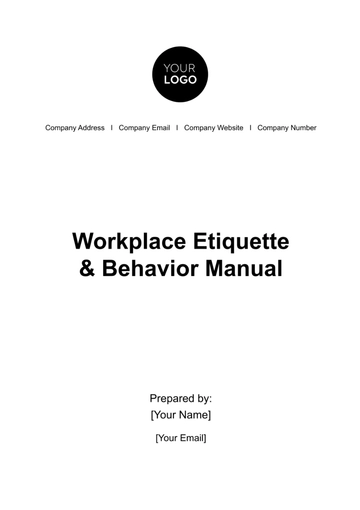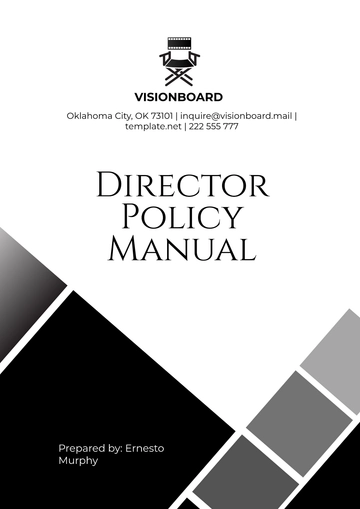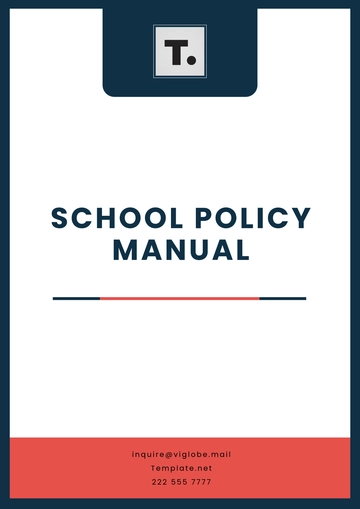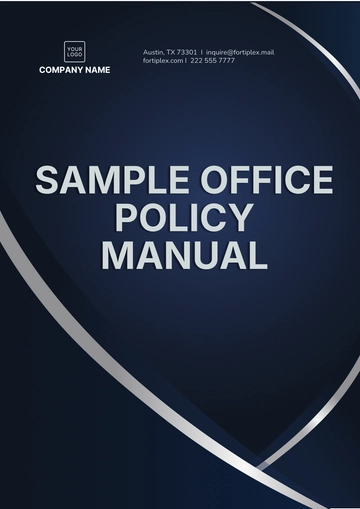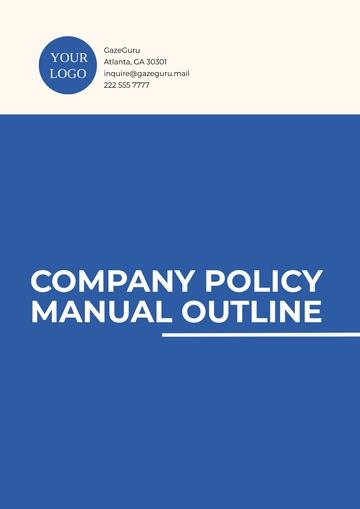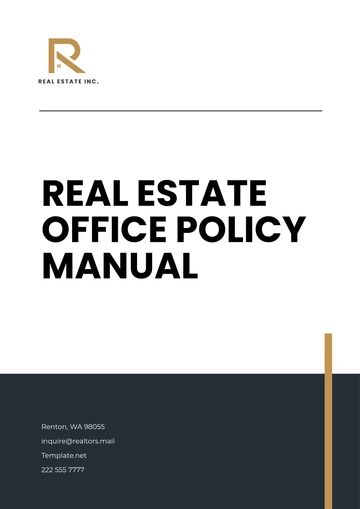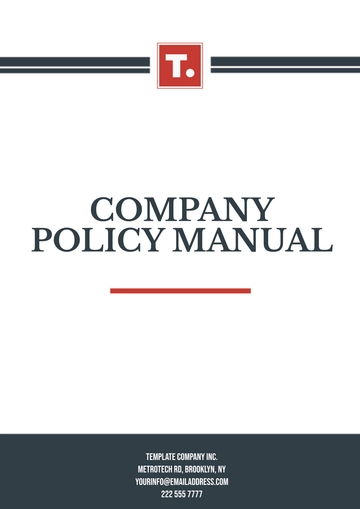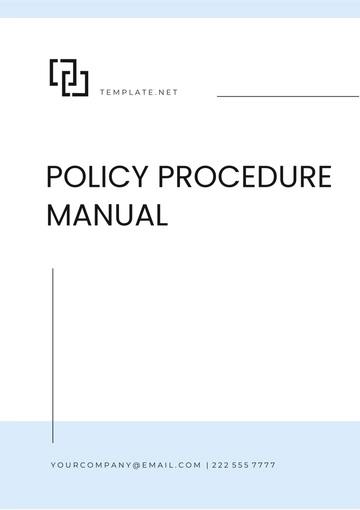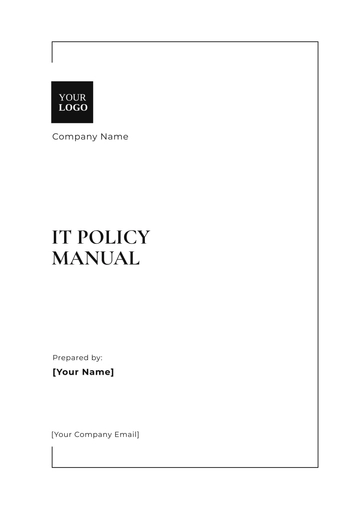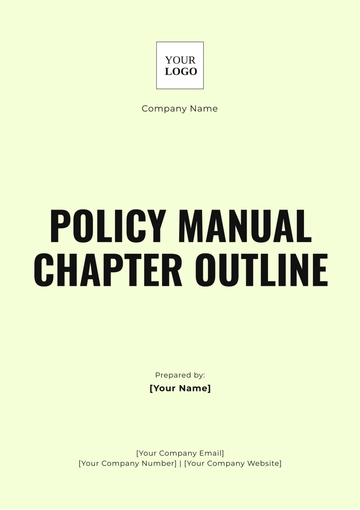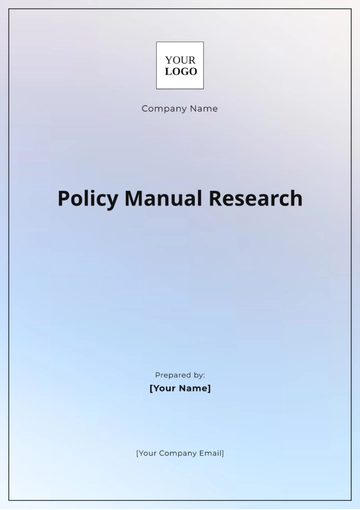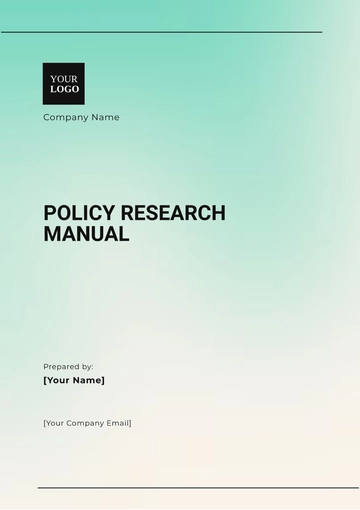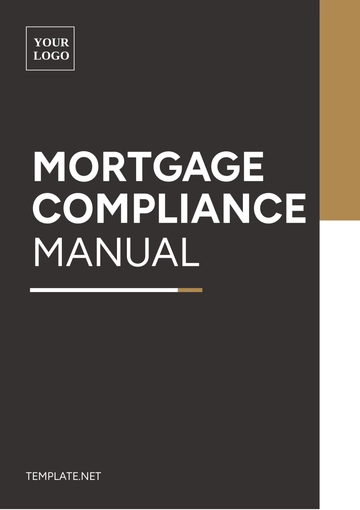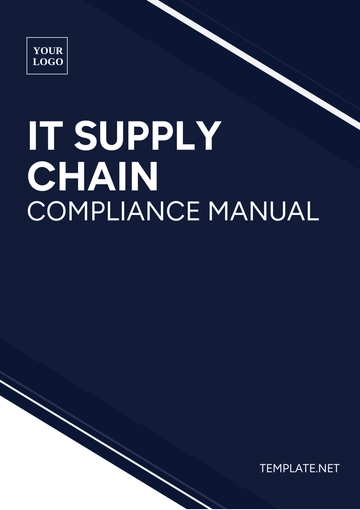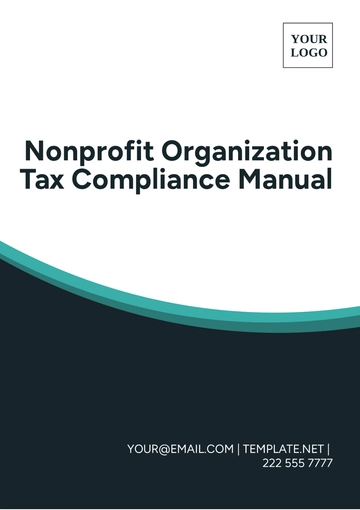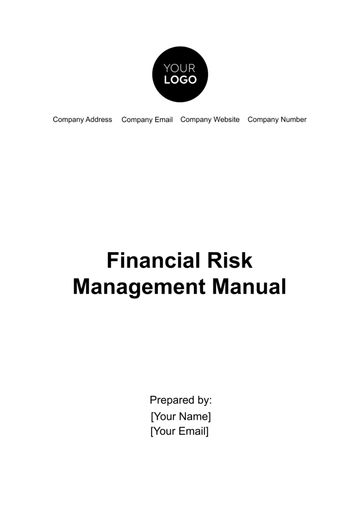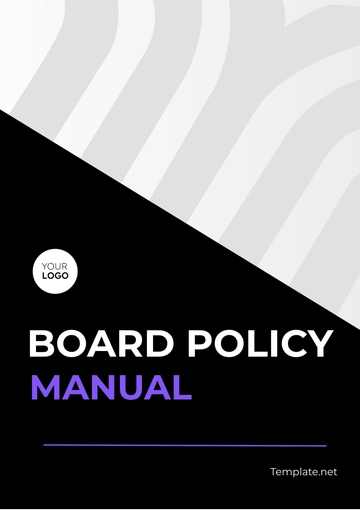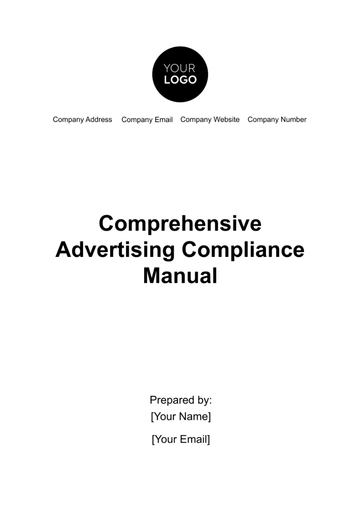Free Telecommuting and Flexible Work Arrangements Manual HR
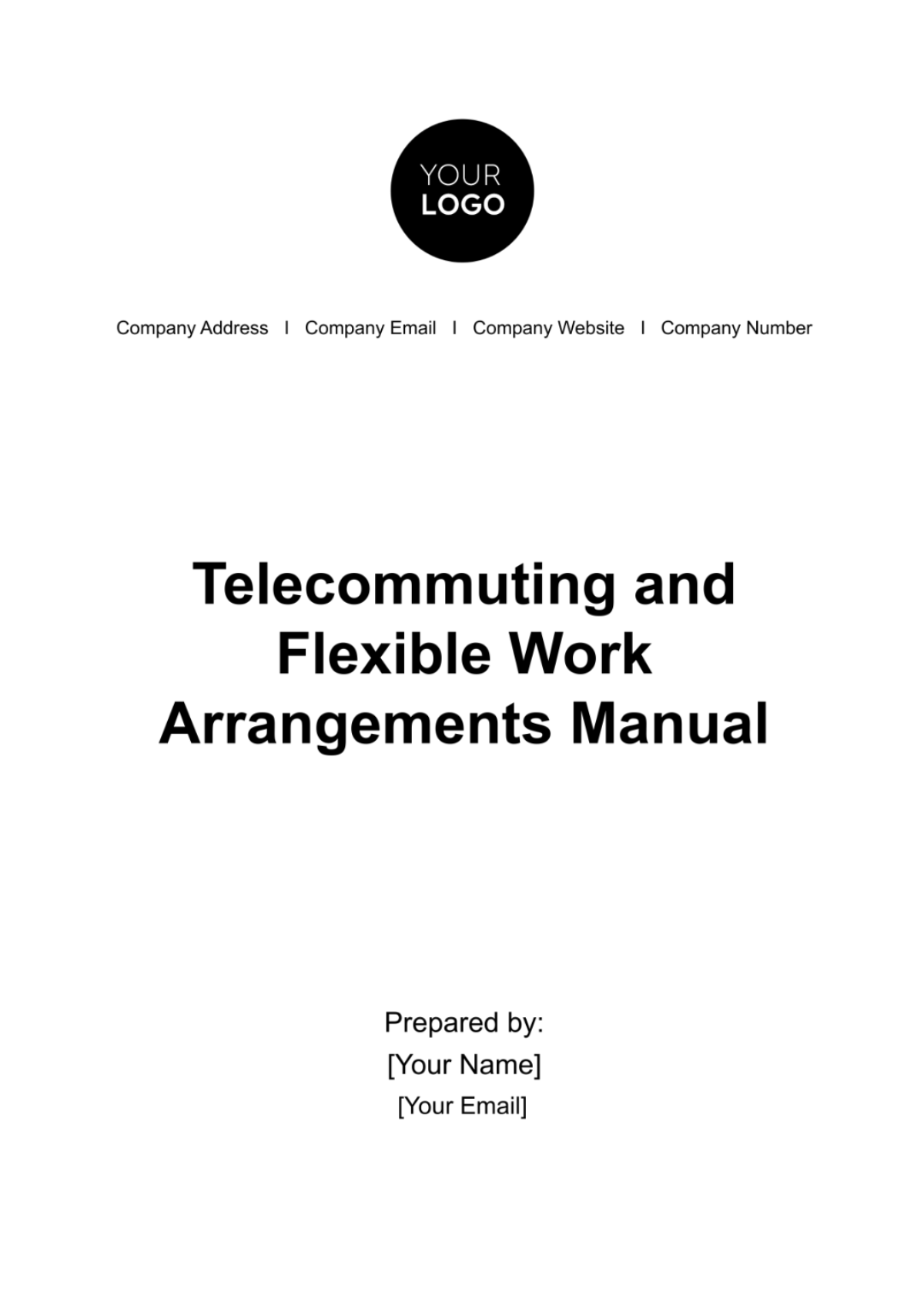
TABLE OF CONTENTS
I. INTRODUCTION...........................................................................................................3
II. DEFINITIONS...............................................................................................................3
III. ELIGIBILITY AND APPROVAL PROCESS..................................................................4
IV. TELECOMMUTING GUIDELINES..............................................................................6
V. FLEXIBLE WORK ARRANGEMENTS..........................................................................6
VI. DATA SECURITY AND CONFIDENTIALITY..............................................................7
VII. COMMUNICATION AND COLLABORATION...........................................................8
VIII. HEALTH AND SAFETY............................................................................................10
IX. TERMINATION OF TELECOMMUTING OR FLEXIBLE WORK ARRANGEMENTS..11
X. REVIEW AND REVISION...........................................................................................12
Document Version: 1.0 Effective Date: January 1, 2050
I.INTRODUCTION
Purpose
The purpose of the Telecommuting and Flexible Work Arrangements Manual at [Your Company Name] is to establish clear guidelines and procedures for employees and management regarding telecommuting and flexible work arrangements. This manual seeks to strike a harmonious balance between employees' work and personal lives, promoting productivity, job satisfaction, and the overall success of our organization.
Scope
This manual applies to all eligible employees of [Your Company Name], regardless of department or job role, who wish to explore telecommuting or flexible work arrangements as part of their employment. Whether you are a full-time employee, part-time worker, or contract staff member, these guidelines apply to you. The principles outlined here are designed to accommodate a wide range of business functions within our diverse organization.
Policy Statement
[Your Company Name] recognizes the importance of providing our employees with the opportunity to achieve a work-life balance that suits their needs and responsibilities. We are committed to supporting telecommuting and flexible work arrangements when feasible, as they contribute to creating a more adaptable and efficient work environment. This policy emphasizes our dedication to fostering a culture of trust, flexibility, and performance excellence while ensuring that our core business objectives remain a priority.
II. DEFINITIONS
Telecommuting
Telecommuting, often referred to as remote work or telework, is a work arrangement where employees have the flexibility to perform their job responsibilities remotely. This typically means working from a location other than the traditional office, such as from home or other off-site locations. Telecommuting relies on technology, such as computers, internet connectivity, and digital communication tools, to connect with colleagues, access company resources, and carry out tasks efficiently.
Flexible Work Arrangements
Flexible work arrangements encompass various options for altering the standard work schedule, location, or structure. These arrangements are designed to provide employees with greater autonomy in managing their work-life balance. Flexible work arrangements can include, but are not limited to, adjusted working hours, compressed workweeks, job-sharing, and part-time employment. They allow employees to tailor their work schedules and conditions to better align with their personal needs, family responsibilities, and individual preferences.
III. ELIGIBILITY AND APPROVAL PROCESS
Eligibility Criteria
Employees seeking telecommuting or flexible work arrangements must meet the following eligibility criteria:
CRITERIA | DESCRIPTION |
Performance | Employees must demonstrate consistent and satisfactory performance in their current roles. |
Reliability | Employees should have a track record of reliability, meeting deadlines, and adhering to schedules. |
Technology Competence | Proficiency in using relevant technology and tools for remote work is essential. |
Job Compatibility | Not all roles are suitable for telecommuting or flexible arrangements. The nature of the job and its compatibility with remote work must be assessed. |
Length of Service | In general, employees should have completed a minimum of 3 months of service with [Your Company Name] to be eligible. |
Request and Approval Procedure
Employees interested in telecommuting or flexible work arrangements should follow this procedure:
Formal Request
Employees submit a formal written request to their immediate supervisor, outlining their proposed telecommuting or flexible work arrangement, including work hours, days, or other relevant details.
Supervisory Review
Supervisors evaluate the request, considering the eligibility criteria and business needs. They may consult with Human Resources and other relevant departments, if necessary.
Approval or Denial
The supervisor communicates the decision to the employee within 3 business days. If approved, the supervisor and employee should mutually agree on the specifics of the arrangement.
Trial Period
A trial period of 3 weeks or more may be established to assess the suitability of the arrangement for both the employee and the company.
Final Approval
After the trial period, the supervisor reviews the arrangement's effectiveness with the employee. If deemed successful, it receives final approval.
Duration and Renewal
Telecommuting or flexible work arrangements are typically approved for an initial period of 3 months.
Employees may submit a renewal request at least 2 weeks before the current arrangement's expiration.
Renewals are subject to continued performance, business needs, and supervisor approval.
IV. TELECOMMUTING GUIDELINES
Workspace and Equipment
Employees should ensure a suitable workspace at their remote location, which meets ergonomic standards. [Your Company Name] may provide guidelines or allowances for equipment and furniture to support a productive workspace.
Communication and Connectivity
Employees must maintain regular communication with their team and supervisor, including responding promptly to emails, calls, and messages during working hours.
A reliable high-speed internet connection is essential for uninterrupted work.
Working Hours and Breaks
Telecommuting employees should adhere to their agreed-upon working hours, taking breaks as appropriate and in accordance with labor laws.
It is important to establish boundaries between work and personal life to prevent overworking.
Performance Evaluation
Performance expectations for telecommuting employees align with those in the office.
Supervisors will assess performance based on agreed-upon goals and objectives. Regular performance reviews are conducted, with feedback and coaching provided as needed.
V. FLEXIBLE WORK ARRANGEMENTS
Types of Flexible Work Arrangements
Employees at [Your Company Name] have the opportunity to request various types of flexible work arrangements, depending on their individual needs and job responsibilities. The following options are available:
Flextime: Employees can adjust their daily work hours to better align with personal obligations, provided they meet their required work hours and core hours for collaboration.
Compressed Workweeks: This arrangement allows employees to work longer hours on fewer days, such as four 10-hour days, provided they maintain their required weekly hours.
Job Sharing: Employees may request to share a full-time position with another employee, with responsibilities and workload divided accordingly.
Part-Time Work: Employees can reduce their work hours to part-time status, subject to approval, while retaining certain benefits.
Request and Approval Process
Employees interested in a flexible work arrangement must submit a formal request through the HR department. The request should include details of the desired arrangement, the reason for the request, and how the employee plans to ensure continued productivity and collaboration. HR will review the request in consultation with the employee's supervisor.
Compliance with Company Policies
Employees approved for flexible work arrangements must adhere to all company policies and guidelines, including those related to performance, attendance, confidentiality, and security. Any deviation from these policies may result in a review of the arrangement and possible termination if compliance is not maintained.
VI. DATA SECURITY AND CONFIDENTIALITY
Data Protection
Employees engaged in telecommuting or flexible work arrangements must prioritize data security. They are responsible for ensuring that all company data, both physical and digital, is protected from unauthorized access or breaches.
Physical Data: Any physical documents or company assets taken off-site must be stored securely and not accessible to unauthorized individuals.
Digital Data: All digital files and communications must adhere to company cybersecurity protocols. Employees should use company-approved devices and networks when accessing company data remotely.
Secure Handling of Company Assets
Employees must ensure the secure handling of company assets, whether at the workplace or in a remote location. This includes:
Properly locking and securing company-issued laptops, smartphones, and other devices when not in use.
Encrypting and protecting sensitive data stored on personal or company devices to prevent unauthorized access.
Safeguarding access credentials, such as passwords and PINs, to prevent data breaches or unauthorized use of company systems.
Confidentiality Obligations
Maintaining confidentiality is a fundamental aspect of remote work. Employees must uphold all confidentiality obligations outlined in company policies, including:
Not discussing or disclosing sensitive company information with unauthorized individuals or in non-secure environments.
Using secure communication channels and encryption when transmitting confidential data.
Reporting any potential breaches or security vulnerabilities to the IT department promptly.
VII. COMMUNICATION AND COLLABORATION
Communication Tools
In today's digital age, effective communication tools are essential for seamless collaboration among telecommuting employees. [Your Company Name] provides a range of communication platforms to facilitate real-time interactions, document sharing, and project tracking. These tools include:
Video Conferencing: We encourage the use of video conferencing platforms such as Zoom, Microsoft Teams, or Google Meet for face-to-face virtual meetings. This ensures that employees can maintain personal connections and engage in productive discussions.
Instant Messaging: Tools like Slack or Microsoft Teams chat provide a quick and efficient way for team members to communicate throughout the workday. Use these platforms for casual conversations, quick updates, and urgent queries.
Email: Traditional email remains an important communication channel. However, we recommend using it judiciously for formal correspondence, document sharing, and archival purposes.
Project Management Software: Platforms like Trello, Asana, or Monday.com help teams organize tasks, set deadlines, and track project progress. These tools are particularly useful for managing collaborative projects.
Meetings and Reporting
Effective virtual meetings are crucial for maintaining team cohesion and project alignment. When conducting remote meetings, consider the following guidelines:
Schedule Regular Check-Ins: Establish a regular meeting schedule to keep team members connected. Daily or weekly stand-up meetings are effective for quick updates, while bi-weekly or monthly meetings can focus on broader discussions and goal-setting.
Set Agendas: Always create and distribute meeting agendas in advance. Clear objectives and topics ensure that meetings stay on track and remain productive.
Encourage Participation: Encourage active participation from all team members. Use video during virtual meetings to enhance engagement and create a sense of presence.
Document Meeting Minutes: Designate someone to record meeting minutes, summarizing key points, action items, and decisions. Share these minutes with participants after the meeting.
Use Screen Sharing: Utilize screen-sharing capabilities to present documents, reports, or visuals during discussions. This ensures that all participants have access to the same information.
Follow-Up: After each meeting, send a follow-up email summarizing key takeaways and action items. This helps reinforce accountability and provides a clear record of commitments.
Team Collaboration
Effective team collaboration is the cornerstone of successful telecommuting arrangements. [Your Company Name] encourages collaborative practices that foster creativity, innovation, and shared goals:
Virtual Team-Building Activities: Engage in virtual team-building exercises to strengthen connections among remote team members. Activities like virtual happy hours, online games, or collaborative challenges can help build camaraderie.
Shared Document Repositories: Store documents, project files, and resources in shared repositories like Google Drive, Dropbox, or SharePoint. This ensures that team members can access necessary materials conveniently.
Collaboration Tools: Use collaboration tools like Google Workspace or Microsoft 365 for real-time document editing, simultaneous work on projects, and collaborative brainstorming.
Clear Communication Channels: Establish clear communication channels for specific purposes, such as project updates, task assignments, and general discussions. This prevents information overload and ensures that messages reach the relevant audience.
VIII. HEALTH AND SAFETY
Ergonomics and Comfort
Creating an ergonomic and comfortable home workspace is vital for telecommuting employees. Poor ergonomics can lead to discomfort and health issues. Here are some guidelines to ensure a comfortable and safe workspace:
Ergonomic Furniture: If possible, invest in ergonomic furniture, including an adjustable chair and desk. Ensure that your chair provides proper lumbar support.
Monitor Placement: Position your computer monitor at eye level to reduce strain on your neck and eyes. Use a monitor stand or adjustable arm if necessary.
Keyboard and Mouse: Place your keyboard and mouse within easy reach, and maintain a neutral wrist position while typing. Consider using an ergonomic keyboard and mouse.
Lighting: Ensure your workspace is well-lit to reduce eye strain. Use adjustable desk lamps to control lighting levels.
Breaks and Movement: Take regular breaks to stretch and move around. Incorporate short walks or exercises into your daily routine to combat prolonged sitting.
Mental and Physical Health
Maintaining mental and physical health while telecommuting is essential for well-being and productivity:
Work-Life Balance: Set clear boundaries between work and personal life. Establish a designated workspace and adhere to regular working hours to maintain a healthy balance.
Mental Health Support: [Your Company Name] provides access to mental health resources and encourages employees to seek support when needed. Reach out to HR for confidential assistance.
Physical Health: Incorporate regular exercise into your routine, even if it's a short home workout. Stay hydrated and maintain a balanced diet to support overall health.
Stress Management: Practice stress management techniques, such as mindfulness, meditation, or deep breathing exercises, to alleviate work-related stress.
Reporting Safety Concerns
If you encounter safety concerns related to your telecommuting environment, promptly report them to your supervisor or HR. [Your Company Name] takes employee safety seriously and will take appropriate measures to address any issues raised.
IX. TERMINATION OF TELECOMMUTING OR FLEXIBLE WORK ARRANGEMENTS
Circumstances for Termination
Telecommuting and flexible work arrangements may be terminated under the following circumstances:
Performance Issues: If an employee's performance significantly declines while working remotely or using flexible arrangements, and efforts to address these issues prove unsuccessful, the arrangement may be terminated.
Operational Needs: In cases where changes in business operations or job requirements make telecommuting or flexible arrangements impractical or incompatible with the employee's role, the arrangement may be terminated.
Breach of Policy: Any violation of the telecommuting and flexible work arrangements policy, including data security breaches, unauthorized use of company assets, or non-compliance with company policies, may result in the termination of the arrangement.
Mutual Agreement: In some instances, employees and management may mutually agree to terminate the telecommuting or flexible work arrangement due to changes in personal circumstances, job role, or organizational needs.
Return of Company Property
Upon the termination of a telecommuting or flexible work arrangement, employees are required to return any company property, equipment, or materials provided for remote work promptly. This includes laptops, mobile devices, security tokens, access cards, and any confidential or proprietary documents or data. Failure to return company property may result in disciplinary actions.
Transition Plan
To facilitate a smooth transition from telecommuting or flexible work arrangements to the regular on-site work schedule, a transition plan will be developed in collaboration between the employee and their manager. The plan will address the following:
Return Schedule: Establish a specific date for the employee's return to the regular work location and schedule.
Handover of Responsibilities: Ensure a seamless transfer of job responsibilities, projects, and tasks to the appropriate team members.
Equipment and Material Return: Confirm the return of all company property, documents, and materials used during the telecommuting or flexible work arrangement.
Training or Reorientation: Provide any necessary training or reorientation to help the employee readjust to on-site work, especially if there have been significant changes during the remote work period.
Performance Expectations: Clearly communicate performance expectations and goals following the return to the regular work environment.
X. REVIEW AND REVISION
Policy Review
This Telecommuting and Flexible Work Arrangements Manual will undergo regular reviews to ensure that it aligns with the evolving needs of [Your Company Name] and complies with relevant employment laws and regulations. Reviews will be conducted at least annually, or as necessary based on changing circumstances.
Policy Revision
[Your Company Name] reserves the right to revise this manual to reflect updates in company policies, technology, regulations, or other factors that may affect telecommuting and flexible work arrangements. Employees will be notified of any significant revisions, and they will have access to the most up-to-date version of the manual. Employee feedback will be considered during the revision process to maintain fairness and transparency.
- 100% Customizable, free editor
- Access 1 Million+ Templates, photo’s & graphics
- Download or share as a template
- Click and replace photos, graphics, text, backgrounds
- Resize, crop, AI write & more
- Access advanced editor
Unlock the future of work with our Telecommuting and Flexible Work Arrangements Manual HR Template. Tailored for diverse industries, this comprehensive and easy-to-use guide empowers your organization to implement effective remote work policies, fostering work-life balance, data security, and collaboration. Seamlessly adapt to evolving workplace dynamics with this template product today!


